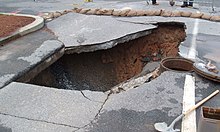| Revision as of 04:16, 14 November 2005 edit203.59.194.198 (talk)No edit summary← Previous edit | Revision as of 04:22, 14 November 2005 edit undoVsmith (talk | contribs)Administrators272,935 editsm Reverted edits by 203.59.194.198 to last version by Neoneo13Next edit → | ||
| Line 1: | Line 1: | ||
| ] | ] | ||
| '''Sinkholes''', also known as |
'''Sinkholes''', also known as '''sinks''', '''dolines''' (in Slavic languages ''dolina'' means ''valley''), and ''']s''', are formed by the ] of ] roofs and are a feature of landscapes that are based on ] ]. The result is a depression in the surface topography. This may range anywhere from a small, gentle earth-lined depression, to a large, ]-lined chasm. Most often there is a small area of ] exposure near or at the bottom of a sinkhole, and a patent opening into the cave below may or may not be visible. In the case of exceptionally large sinkholes, such as Cedar Sink at ], there may actually be a ] or river flowing into the bottom of the sink from one side and out the other side. | ||
| Sinkholes often form in low areas where they form ] outlets for a surface drainage ]. They may also form in high and dry locations. ] has been known for having frequent sinkholes, especially in the central part of the state. | Sinkholes often form in low areas where they form ] outlets for a surface drainage ]. They may also form in high and dry locations. ] has been known for having frequent sinkholes, especially in the central part of the state. | ||
Revision as of 04:22, 14 November 2005

Sinkholes, also known as sinks, dolines (in Slavic languages dolina means valley), and cenotes, are formed by the collapse of cave roofs and are a feature of landscapes that are based on limestone bedrock. The result is a depression in the surface topography. This may range anywhere from a small, gentle earth-lined depression, to a large, cliff-lined chasm. Most often there is a small area of rock exposure near or at the bottom of a sinkhole, and a patent opening into the cave below may or may not be visible. In the case of exceptionally large sinkholes, such as Cedar Sink at Mammoth Cave National Park, there may actually be a stream or river flowing into the bottom of the sink from one side and out the other side.
Sinkholes often form in low areas where they form drainage outlets for a surface drainage basin. They may also form in high and dry locations. Florida has been known for having frequent sinkholes, especially in the central part of the state.
Sinkholes are usually but not always linked with a karst landscape. Karst represents a set of surface features that are characteristic of limestone under the soil. In many such regions, there may be hundreds or even thousands of sinkholes in a small area so that the earth as seen from the air looks pock-marked. Often in such areas there are few or no flowing streams on the surface because the drainage is all sub-surface.
Sinkholes have for centuries been used as disposal sites for various forms of waste. An unfortunate consequence has been the pollution of ground water resources, with serious health implications in such areas.
Sinkholes also form from human activity, such as the rare but still occasional collapse of abandoned mines in places like West Virginia. More commonly, sinkholes occur in urban areas due to water main breaks or sewer collapses when old pipes give way. They can also occur from the overpumping and extraction of ground water and subsurface fluids.